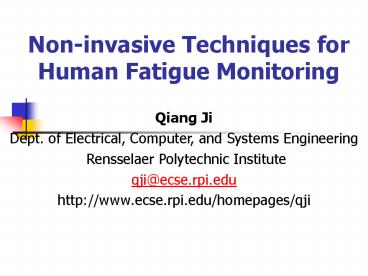Noninvasive Techniques for Human Fatigue Monitoring - PowerPoint PPT Presentation
Title:
Noninvasive Techniques for Human Fatigue Monitoring
Description:
Facial expressions. Eyelid Movements ... Recognize certain facial expressions related to fatigue like yawning. ... Facial expression demo. Fatigue Modeling ... – PowerPoint PPT presentation
Number of Views:55
Avg rating:3.0/5.0
Title: Noninvasive Techniques for Human Fatigue Monitoring
1
Non-invasive Techniques for Human Fatigue
Monitoring
Qiang Ji Dept. of Electrical, Computer, and
Systems Engineering Rensselaer Polytechnic
Institute qji_at_ecse.rpi.edu http//www.ecse.rpi.edu
/homepages/qji
2
(No Transcript)
3
Visual Behaviors
- Visual behaviors that typically reflect a
- person's level of fatigue include
- Eyelid movement
- Head movement
- Gaze
- Facial expressions
4
Eyelid Movements
- Tracking Eyes
- Develop techniques that can robustly track eyes
under different face orientations, illuminations,
and large head movements. - Compute Eye movement parameters
- PERCLOS
- Average Eye Closure/Open Speed (AECS)
5
Eyes tracking demo
6
PERCLOS measurement over time
7
Average Eye Closure Speed Over time
8
(No Transcript)
9
(No Transcript)
10
Gaze (Pupil Movements)
- Real time gaze tracking
- No calibration is needed and allows natural head
movements !. - Gaze parameters
- Spatial gaze distribution overtime
- Ratio of fixation time to saccade time.
11
Gaze distribution over time while alert
12
Gaze distribution over time under fatigue
13
(No Transcript)
14
Head Movement
- Real time head pose tracking
- Perform 3D face pose estimation from a single
uncalibrated camera. - Head movement parameters
- Head tilt frequency over time
- Percentage of side views (PerSideV)
15
(No Transcript)
16
(No Transcript)
17
Facial Expressions
- Tracking facial features
- Recognize certain facial expressions related to
fatigue like yawning. - Building a database of fatigue expressions.
18
Facial expression demo
19
Fatigue Modeling
- Knowledge of fatigue is uncertain and from
different levels of abstraction. - Fatigue represents the affective state of an
individual, is not observable, and can only be
inferred.
20
Overview of Our Approach
- Propose a probabilistic framework based on
Bayesian Networks (BN) to - model fatigue.
- systematically integrate various sources of
information related to fatigue. - infer and predict fatigue from the available
observations and the relevant contextual
information.
21
Bayesian Networks Construction
- A BN model consists of target hypothesis
variables (hidden nodes) and information
variables (information nodes). - Fatigue is the target hypothesis variable that we
intend to infer. - Other contextual factors and visual cues are the
information nodes.
22
Causes for Fatigue
- Major factors to cause fatigue include
- Sleep quality.
- Circadian rhythm (time of day).
- Physical conditions.
- Working environment.
23
Bayesian Network Model for Monitoring Human
Fatigue
24
Interface with Vision Module
- An interface has been developed to connect the
output of the computer vision system with the
information fusion engine. - The interface instantiates the evidences of the
fatigue network, which then performs fatigue
inference and displays the fatigue index in real
time.
25
Conclusions
- Developed non-intrusive real-time computer vision
techniques to extract multiple fatigue parameters
related to eyelid movements, gaze, head movement,
and facial expressions. - Develop a probabilistic framework based on
Bayesian networks to model and integrate
contextual and visual cues information for
fatigue monitoring.































